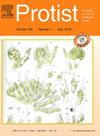Dinotoms possess two evolutionary distinct autophagy-related ubiquitin-like conjugation systems
IF 1.9
3区 生物学
Q4 MICROBIOLOGY
引用次数: 0
Abstract
Autophagy is an intracellular degradation mechanism by which cytoplasmic materials are delivered to and degraded in the lysosome-fused autophagosome (autolysosome) and proposed to have been established at an early stage of eukaryotic evolution. Dinoflagellates harboring endosymbiotic diatoms (so-called “dinotoms”), which retain their own nuclei and mitochondria in addition to plastids, have been investigated as an intermediate toward the full integration of a eukaryotic phototroph into the host-controlled organelle (i.e., plastid) through endosymbiosis. Pioneering studies systematically evaluated the degree of host governance on several metabolic pathways in the endosymbiotic diatoms (ESDs). However, little attention has been paid to the impact of the endosymbiotic lifestyle on the autophagy operated in the ESDs. In this study, we searched for ATG3, ATG4, ATG5, ATG7, ATG8, ATG10, and ATG12, which are required for autophagosome formation, in the RNA-seq data from dinotoms Durinskia baltica and Kryptoperidinium foliaceum. We detected two evolutionally distinct sets of the ATG proteins in the dinotom species, one affiliated with the dinoflagellate homologs and the other with the diatom homologs in phylogenetic analyses. The results suggest that the ATG proteins descended from the diatom taken up by the dinoflagellate host persist for autophagosome formation and, most likely, autophagy.
恐龙在进化过程中拥有两种不同的自噬相关泛素类连接系统
自噬是一种细胞内降解机制,通过这种机制,细胞质物质被运送到溶酶体融合的自噬体(自溶酶体)中并在其中降解。内共生硅藻(即所谓的 "硅藻")是真核生物光营养体通过内共生完全融入宿主控制的细胞器(即质体)的中间产物。开创性的研究系统地评估了宿主对内共生硅藻(ESD)中几种代谢途径的控制程度。然而,人们很少关注内共生生活方式对ESDs自噬的影响。在这项研究中,我们从Durinskia baltica和Kryptoperidinium foliaceum的RNA-seq数据中寻找了自噬体形成所需的ATG3、ATG4、ATG5、ATG7、ATG8、ATG10和ATG12。在系统进化分析中,我们在恐龙物种中发现了两组进化不同的 ATG 蛋白,一组与甲藻同源,另一组与硅藻同源。结果表明,被双鞭毛虫宿主吸收的硅藻后裔ATG蛋白持续用于自噬体的形成,并很可能用于自噬。
本文章由计算机程序翻译,如有差异,请以英文原文为准。
求助全文
约1分钟内获得全文
求助全文
来源期刊

Protist
生物-微生物学
CiteScore
3.60
自引率
4.00%
发文量
43
审稿时长
18.7 weeks
期刊介绍:
Protist is the international forum for reporting substantial and novel findings in any area of research on protists. The criteria for acceptance of manuscripts are scientific excellence, significance, and interest for a broad readership. Suitable subject areas include: molecular, cell and developmental biology, biochemistry, systematics and phylogeny, and ecology of protists. Both autotrophic and heterotrophic protists as well as parasites are covered. The journal publishes original papers, short historical perspectives and includes a news and views section.
 求助内容:
求助内容: 应助结果提醒方式:
应助结果提醒方式:


